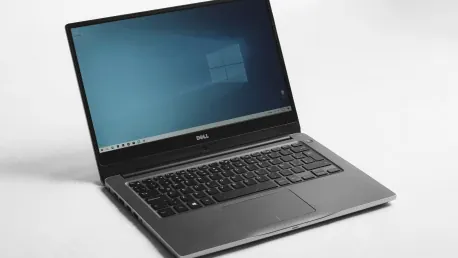Dell’s XPS series, a stalwart in the ultraportable laptop domain since 2012, bids adieu with the XPS 13 9350. Announced at CES 2025, this model serves as the final entry in the iconic lineup, guiding Dell towards more streamlined “Pro,” “Max,” and “Premium” labels. As the curtain falls on the XPS series, the 9350 embodies a fusion of innovation and enduring design flaws, marking both the apex and nadir of Dell’s engineering prowess.
Design and Build Quality
The Dell XPS 13 9350 stays true to its lineage with a CNC-machined aluminum body. It continues to impress with its sleek, elegant lines and a minimal weight of 1.18 kg, ideal for on-the-go professionals. This iteration conveys sophistication through two color options: graphite gray and platinum silver. Graphite gray garners particular favor among users for its moody aesthetics and better resistance to fingerprints and smudges.
Encapsulating meticulous craftsmanship, the 9350 features a refined dark interior paired with a Gorilla Glass touchpad, contributing to the laptop’s robust build quality and visual appeal. Dell’s prowess in creating a solid yet elegant device culminates here, reinforcing the XPS series’ legacy in industrial design. However, despite its fine finishes and attention to detail, certain design choices undermine the overall user experience, leaving professionals in a dichotomous space of admiration and frustration.
Specifications and Configurations
Under the hood, the XPS 13 9350 offers formidable configurations. At the base, it comes with an Intel Core Ultra 5 226V, supported by 16GB of LPDDR5X RAM and a 512GB NVMe SSD. This particular configuration promises adequate power for day-to-day activities while ensuring a seamless user experience. Complementing the internal power is a 13.4-inch, 1,920 x 1,200 IPS display, which strikes a balance between resolution and energy efficiency.
Prospective buyers can, however, navigate a maze of upgrade options, which include enhancements in the processor, RAM, storage, and display quality. Upgrading the system drives the cost upward incrementally, sometimes delivering only modest performance returns. For instance, doubling the RAM requires upgrading to an Intel Core Ultra 5 258V, raising the base price significantly without proportional gains in processing speed. Similarly, expanding storage to 1TB or 2TB and opting for display upgrades such as a 3K OLED touchscreen or QHD+ IPS comes at a premium, presenting a cost-benefit conundrum to potential buyers.
Display
A crowning feature of the 9350 is its innovative display technology. Boasting the world’s first tandem OLED configuration, this model integrates two OLED panels to enhance overall brightness and mitigate burn-in risks. The 2,880 x 1,800 resolution provides an immersive experience, delivering exceptional contrast ratios and deep black levels. Users find themselves enthralled by the vividness and intensity of the visuals, which democratize professional-grade color accuracy for everyday tasks.
Despite these advances, the display’s HDR functionality falls short of expectations. Even rigorous calibration efforts fail to address the inconsistencies, with highlights in HDR content frequently appearing blown out. Such issues diminish the enjoyment of streaming high-definition content on platforms like YouTube and Netflix. While the display gains acclaim for its innovative approach, these performance setbacks cast a shadow over its potential, leaving room for critiques and discussions on future improvements.
Keyboard and Touchpad
The controversial keyboard design from the 2023 XPS 13 Plus returns, much to the dismay of many users. The zero-lattice keys, intended to offer larger key caps within a compact footprint, result in a higher error rate during typing exercises. Placing the combined power button and fingerprint reader near the backspace key only complicates matters, with aggressive deletion attempts inadvertently turning off the laptop.
Furthermore, Dell’s adoption of capacitive touch buttons for function keys compromises the tactile feedback essential for seamless navigation. Routine actions like pressing the Escape or Delete keys transform into cumbersome experiences, inviting user frustration. Conversely, the expansive touchpad, hidden beneath a Gorilla Glass panel and spanning the laptop’s width, redeems some functionality. Despite the unconventional design choice, the touchpad performs adequately, delivering smooth texture and reliable gesture recognitions that align with Dell’s commitment to enhancing user experience.
Connectivity
Connectivity remains a significant setback for the XPS 13 9350. With merely two Thunderbolt 4 USB-C ports, the practical usage becomes drastically constrained. The glaring absence of a 3.5 mm audio jack poses a further inconvenience, demanding adapters for basic functionality. Despite incorporating the latest Wi-Fi 7 and Bluetooth 5.4 capabilities, these limitations can be deal-breakers, especially when juxtaposed against rivals like the MacBook Air, which offers more comprehensive port options including a headphone socket and MagSafe port.
Such restrictive connectivity options reflect a growing trend towards minimalism, though it places the user in a challenging position when existing peripherals and accessories demand broader compatibility. The reduction in port variety limits the scope of practical applications, reiterating the need for a balanced approach between aesthetic minimalism and functional versatility.
Performance and Battery Life
Integrating Intel’s Lunar Lake chips, the 9350 aims to address prior deficiencies identified in its predecessors. Single-core performance sees measurable improvements; however, multi-core functionality encounters hurdles owing to reduced core counts. While top-end models offer clock speeds up to 5.1 GHz, substantial performance gains over previous generations remain limited, prompting discussions on the tangible benefits of these upgrades.
The inclusion of Intel’s Xe2 graphics architecture revitalizes GPU capabilities, making casual gaming viable on this ultraportable device. The ARC Graphics 140V GPU showcases significant benchmark improvements, outperforming Qualcomm’s Snapdragon by a notable margin. While GPU advancements are commendable, the real-world impact of these enhancements on streamlined tasks and applications remains a focal point of debate among users.
Battery life is another area where configuration plays a decisive role. The OLED variant achieves an impressive 14 hours in rundown tests, outperforming its predecessor yet falling short compared to Qualcomm alternatives that push closer to 17 hours. These differences in battery longevity contribute to the overall decision-making process for prospective buyers, weighing the merits of a high-resolution display against sustained battery performance.
Conclusion
Since its inception in 2012, Dell’s XPS series has been a cornerstone in the world of ultraportable laptops. The line has garnered a loyal following for its sleek design and powerful performance. However, the journey of the XPS series is coming to an end with the announcement of the XPS 13 9350 at CES 2025. This latest model will be the last in the iconic lineup, as Dell shifts its focus to more streamlined branding under the “Pro,” “Max,” and “Premium” labels.
The XPS 13 9350 serves as a fitting conclusion to the storied series. It represents a blend of cutting-edge innovation and some enduring design flaws that have both elevated and hindered Dell’s engineering. On one hand, it offers state-of-the-art features and performance that push the boundaries of what a portable laptop can do. On the other, it retains some of the persistent issues that have been a thorn in the side of users.
The departure of the XPS series marks the end of an era for Dell and its users. As the brand pivots to new naming conventions and a refined product lineup, the legacy of the XPS series will continue to resonate with those who valued its unique combination of style and substance. The XPS 13 9350 stands as a testament to Dell’s commitment to innovation, serving both as a crowning achievement and a reminder of the challenges that come with technological advancements.









